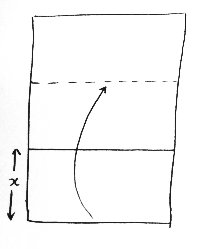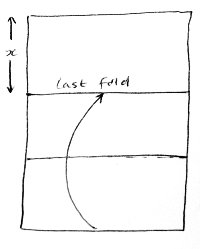Exercise.
A student is applying for a job and folds the covering letter (which is written on a sheet of paper of length 1) into thirds to put it in the envelope, using the following method:


- First a fold is made along a horizontal line distance
from the bottom of the paper (where 0 12 is chosen at random). The paper is unfolded and turned upside down. - Next, the paper is folded so that the bottom edge lies exactly on the last fold just made. The paper is unfolded and turned upside down once again.
- The process in the last paragraph is repeated.
(a) Explain why, if the distance from
the bottom of the first fold is 1=
(b) Prove that
and
for all
(d) Which standard theorem in these notes allows you to conclude from
(c) that
If you are still struggling with the idea of the definition of convergence
think of it as saying whatever the size of the envelope, as long as it is
a small amount more than
. Of course, your job prospects
may also depend on other things too, such as a nice crisp and uncreased
covering letter... ;)